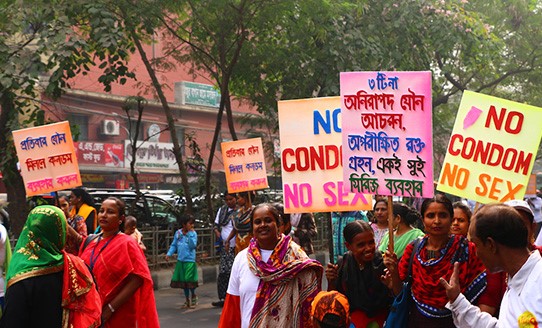Returnee migrant workers spark new HIV fear for Bangladesh
Fearing social ostracism, many patients keep their infection and treatment secret

People take part in a rally to mark World HIV/AIDS Day in Bangladeshi capital Dhaka in 2014. Bangladesh has seen a rise in HIV infections in recent years, health experts say. (ucanews photo)
Eight years ago, Masum Billah (not his real name) moved to Saudi Arabia to work as a private car driver. His employment in the oil-rich Persian Gulf nation brought him both fortune and disaster.
The Muslim man from Noakhali district in southeast Bangladesh improved the economic conditions for his wife and three children.
Masum, now 38, decided to end his overseas employment so that he could start a small business back home. He returned to Bangladesh in December 2018 and opened a grocery shop in his village.
However, his good plans have hit stony ground. He has returned not only with money but also a potentially deadly infection — human immunodeficiency virus (HIV). To make things worse, he has transmitted HIV to his wife.
“I had suffered from fever for a longer period, and after testing in a hospital I was diagnosed HIV-positive. Then my wife was found to have the virus as well. My children are fine and have no signs of the virus, though they have not been tested yet,” Masum told ucanews.
Top of Form
He said he does not know how he got infected but admitted that during his long stay abroad he had unprotected sex with women.
“I don’t feel sad for myself at all, because it was my fault. I am upset that my wife has been infected even though she has not done anything wrong. She does not blame me but continues to support me,” Masum said.
In socially and religiously conservative Bangladesh, HIV/AIDS patients face ostracism, so the family have kept the treatment secret.
“Neither our relatives nor people in the society know about our infection. This might trigger a barrage of social ostracism. We are trying to survive with income from the grocery shop and undergoing treatment to get cured,” Masum said.
Bangladesh, a Muslim-majority nation of more than 160 million, has seen a rise in HIV/AIDS infections in recent years following years of low rates, triggering alarm among the government, NGOs and church health officials.
Bangladesh has about eight million overseas migrant workers who remit about US$15 billion annually, vital for the economy of a largely agricultural and impoverished country.
However, returnee migrant workers like Masum are seen as the biggest carriers of the virus into Bangladesh.
Infections on the rise
Bangladesh has recorded 919 new HIV cases this year so far, up from 865 and 869 cases in 2017 and 2018 respectively, according to the latest report from the National AIDS/STD Program of the Health Ministry, published on Dec. 2 to mark World HIV/AIDS Day. A total of 170 patients have died of AIDS this year
From 2014-16, the annual number of HIV/AIDS patients was 433, 460 and 578 respectively, the report says.
Bangladesh recorded its first HIV case in 1989 and since then 7,374 HIV-infected people have been detected and 1,242 have died.
The number of infections has seen a gradual rise from only 31 cases in 2000. Among infected people, 74 percent are male, 25 percent female and 1 percent transgender.
For years, Bangladesh was considered a “low-prevalence” country for HIV/AIDS, but the scene has been changing due to two major contributing factors, says Dr. Sahmiul Alam, line director of the National AIDS/STD Program.
“We have millions of migrant workers and they are potential carriers of the infection. On the other hand, funding for HIV/AIDS has depleted over the years because donors don’t consider Bangladesh a risky country due to low prevalence. Here, the virus spread mainly through sexual intercourse with an infected person and, due to social ostracism, many patients continue to hide their condition,” Alam told ucanews.
About 50 percent of patients don’t realize they have the infection until the critical stage, while about one third who know seek treatment, he said.
Despite government enthusiasm, HIV/AIDS prevention programs only cover about 30 percent of the population. “Most of our programs are for raising awareness about HIV/AIDS, but we are falling behind in prevention,” Alam added.
According to the United Nations Program on HIV/AIDS (UNAIDS) statistics for 2018, Bangladesh had an estimated 13,000 HIV/AIDS patients and about 6,455 had been detected through government and non-government facilities. Those not detected don’t seek treatment while increasing the risks of spreading infection.
Globally, 37.9 million people were living with HIV/AIDS, while 1.7 million new infections were detected and 770,000 people had died of AIDS-related diseases as of 2018, according to UNAIDS.
Tackling social ostracism
Besides a lack of awareness, social ostracism and a funding crisis deter tackling HIV/AIDS, says Dr. Edward Pallab Rozario, director of health programs at Catholic charity Caritas Bangladesh, which runs a special program for awareness building and support for HIV/AIDS patients.
“Whether Christian or non-Christian, the common problem is a lack of awareness and social stigma attached to HIV/AIDS. We know there are 40 Christian patients with HIV/AIDS, but we think the number should be higher because many Christians work abroad away from families for a long time and face risks of infection,” Rozario told ucanews.
Caritas had to close the project for about seven years due to a lack of donor funding but recently received funding for a two-year project to continue services.
The new funding will enable Caritas to resume services in eight operation areas through collaboration with two archdioceses and six dioceses in Bangladesh.
“Our priority is to raise awareness among people and provide treatment for those infected and support to families, including children. We need to make more and more people realize HIV/AIDS can be prevented if we are aware and it can be cured if we take steps in time,” Rozario added.

